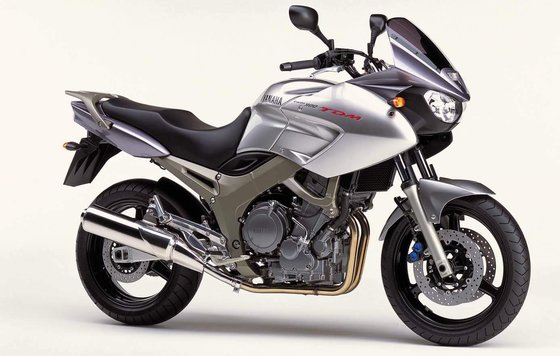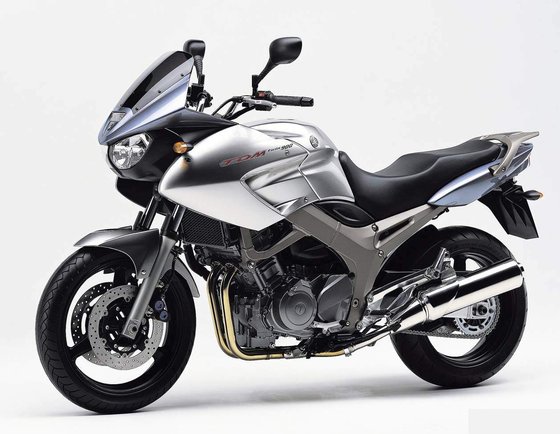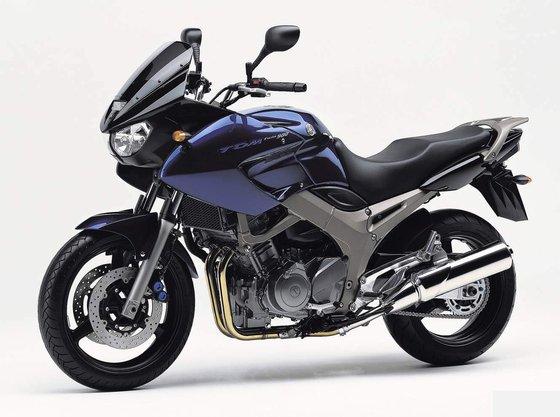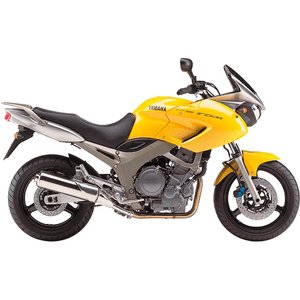Yamaha TDM 900 (2002–2010): A Timeless All-Rounder Tested

Introduction
The Yamaha TDM 900 occupies a unique space in motorcycling history—a machine that defies easy categorization. Produced from 2002 to 2010, this parallel-twin adventure-sport-touring hybrid continues to captivate riders who crave versatility without compromise. After spending a week with a well-maintained 2007 model, it’s clear why this bike still commands a loyal following. Let’s dissect what makes the TDM 900 a cult classic and why it remains relevant for modern riders seeking a jack-of-all-trades.
Engine Performance: Character Over Brutality
At the heart of the TDM 900 lies its 897cc liquid-cooled DOHC 8-valve parallel twin. With 85 HP (63 kW) at 7,500 RPM and 88.8 Nm (65.5 lb-ft) of torque peaking at 6,000 RPM, this isn’t a motor that chases redlines. Instead, it delivers a broad, accessible powerband that prioritizes real-world usability.
The 270-degree crankshaft gives it a throaty, almost V-twin-like character, with minimal vibration through the bars. From 3,000 RPM onward, the TDM pulls with purpose, making overtakes effortless even in higher gears. The switch to fuel injection (a first for the TDM lineage in 2002) ensures crisp throttle response, though purists might miss the raw edge of carbureted predecessors.
The 6-speed transmission is a highlight. Clutch action is light, and shifts are precise, with a tall sixth gear that settles the engine into a relaxed 4,000 RPM at 110 km/h (68 mph). It’s a motor built for covering ground, not chasing lap times—and that’s precisely its charm.
Handling & Comfort: The Sweet Spot Between Agility and Stability

Yamaha’s aluminum diamond frame strikes a perfect balance. At 1485 mm (58.5 inches), the wheelbase is neither too short for stability nor too long for agility. Combined with a dry weight of 192 kg (423 lbs), the TDM feels surprisingly nimble when threading through city traffic, yet planted at highway speeds.
The suspension setup—43mm adjustable preload/rebound forks up front and a link-type rear shock with preload/compression damping—is tuned for comfort without wallowing. Over broken asphalt, the 150mm (5.9 inches) of front travel and 133mm (5.2 inches) at the rear absorb imperfections gracefully. Push hard into a corner, and the chassis communicates clearly, aided by the sticky 120/70-ZR18 front and 160/60-ZR17 rear tire combo.
The riding position is a masterclass in ergonomics. The 825mm (32.5-inch) seat height accommodates most riders, while the upright bars and slight forward lean keep wrists and back happy during long days. Wind protection from the angular fairing is adequate up to 130 km/h (81 mph), though taller riders might crave an aftermarket screen.
Design & Features: Function Meets Quirky Form

The TDM’s styling remains polarizing. Its angular headlights, beak-like front fender, and slab-sided tank scream early-2000s adventure aesthetic. Yet, there’s an undeniable functionality to its design. The 20L (5.3-gallon) fuel tank offers a 350–400 km (217–249 mi) range, while the dual-seat setup (firmer for the rider, plusher for the passenger) invites two-up touring.
Instrumentation is sparse but effective—an analog tachometer flanked by a digital speedometer and basic trip computer. Storage is limited to a small compartment under the passenger seat, a reminder that this bike predates the era of USB ports and TFT displays. What it lacks in tech, it makes up for in mechanical honesty.
Competition: Where Does the TDM 900 Stand?
In its era, the TDM 900 faced rivals that each championed different philosophies:
-
Honda VFR800 (2002–2009)
Honda’s V4 gem offered 108 HP and legendary VTEC sound but weighed 213 kg (470 lbs). While faster in a straight line, it couldn’t match the TDM’s low-end grunt or upright ergonomics. -
Suzuki DL650 V-Strom (2004–2011)
Lighter (188 kg/414 lbs) and cheaper, the V-Strom excelled off-road but delivered a buzzy, less engaging V-twin. The TDM’s road manners and build quality felt premium by comparison. -
Triumph Tiger 955i (2001–2005)
The Tiger’s triple-cylinder engine was smoother, but its 206 kg (454 lbs) weight and taller seat (840mm/33 inches) made it less accessible. Maintenance costs also favored the Yamaha.
The TDM 900 carved its niche by blending the VFR’s sportiness, the V-Strom’s practicality, and the Tiger’s touring capability—all while being easier to live with daily.
Maintenance: Keeping the TDM in Prime Shape
Ownership costs are where the TDM 900 truly shines. Key considerations:
- Valve Adjustments: Every 42,000 km (26,000 mi)—a generous interval. Intake valves: 0.15–0.20mm (0.006–0.008 in), exhaust: 0.23–0.28mm (0.009–0.011 in).
- Oil Changes: Use 10W-40 JASO MA-rated oil. Capacity: 3.8L (4.0 qt) without filter, 3.9L (4.1 qt) with.
- Cooling System: 1.7L (1.8 qt) of ethylene glycol coolant. Check hoses for cracks—common in older models.
- Chain Care: The 118-link O-ring chain lasts longer with regular cleaning and tension set to 45–55mm (1.8–2.2 in).
- Brakes: DOT 4 fluid changes every 2 years prevent sponginess. Upgrade to sintered pads for better bite.
Common upgrades from MOTOPARTS.store:
- High-flow air filters ($45–$75)
- Adjustable levers ($90–$150)
- Progressive-rate suspension springs ($120–$200)
Verdict: The Swiss Army Knife of Motorcycles
The Yamaha TDM 900 isn’t the best at anything—and that’s its greatest strength. It’s a bike that commuting, weekend twisties, and cross-country tours with equal competence. While later models like the MT-09 Tracer have overshadowed it technologically, the TDM’s analog charm and bulletproof reliability keep it relevant. For riders who value substance over specs, this is a modern classic that still deserves a spot in the garage.
Specifications sheet
| Engine | |
|---|---|
| Stroke: | Four-stroke |
| Max power: | 63 kW | 84.0 hp |
| Max torque: | 89 Nm |
| Fuel system: | Electronic Fuel Injection |
| Max power @: | 7500 rpm |
| Displacement: | 897 ccm |
| Max torque @: | 6000 rpm |
| Bore x stroke: | 92.0 x 67.5 mm (3.6 x 2.7 in) |
| Configuration: | Inline |
| Cooling system: | Liquid |
| Compression ratio: | 10.4:1 |
| Lubrication system: | Dry sump |
| Number of cylinders: | 2 |
| Dimensions | |
|---|---|
| Wheelbase: | 1485 mm (58.5 in) |
| Dry weight: | 190 |
| Wet weight: | 223 |
| Seat height: | 825 mm (32.5 in) |
| Overall width: | 800 mm (31.5 in) |
| Overall height: | 1290 mm (50.8 in) |
| Overall length: | 2180 mm (85.8 in) |
| Ground clearance: | 160 mm (6.3 in) |
| Fuel tank capacity: | 20 L (5.3 US gal) |
| Drivetrain | |
|---|---|
| Final drive: | chain |
| Chain length: | 118 |
| Transmission: | 6-speed |
| Rear sprocket: | 42 |
| Front sprocket: | 16 |
| Maintainance | |
|---|---|
| Rear tire: | 160/60-z-17 |
| Engine oil: | 10W40 |
| Front tire: | 120/70-z-18 |
| Break fluid: | DOT 4 |
| Spark plugs: | NGK DPR8EA-9 or NGK DPR8EIX-9 |
| Spark plug gap: | 0.9 |
| Coolant capacity: | 1.7 |
| Forks oil capacity: | 1.1 |
| Engine oil capacity: | 4.7 |
| Engine oil change interval: | Every 5000 km or 2 years |
| Valve clearance (intake, cold): | 0.15–0.20 mm |
| Valve clearance check interval: | 24,000 km (15,000 mi) |
| Valve clearance (exhaust, cold): | 0.23–0.28 mm |
| Recommended tire pressure (rear): | 2.5 bar (36 psi) solo, 2.9 bar (42 psi) with passenger |
| Recommended tire pressure (front): | 2.25 bar (33 psi) |
| Chassis and Suspension | |
|---|---|
| Frame: | Aluminium diamond-shaped |
| Rear brakes: | Single 248 mm disc, 1-piston caliper (ABS on some models) |
| Front brakes: | 2 x 298 mm discs, 4-piston calipers (ABS on some models) |
| Rear suspension: | Link-type monoshock, adjustable rebound/compression damping and preload |
| Front suspension: | 43mm telescopic fork, adjustable rebound damping and preload |
| Rear wheel travel: | 133 mm (5.2 in) |
| Front wheel travel: | 150 mm (5.9 in) |



















